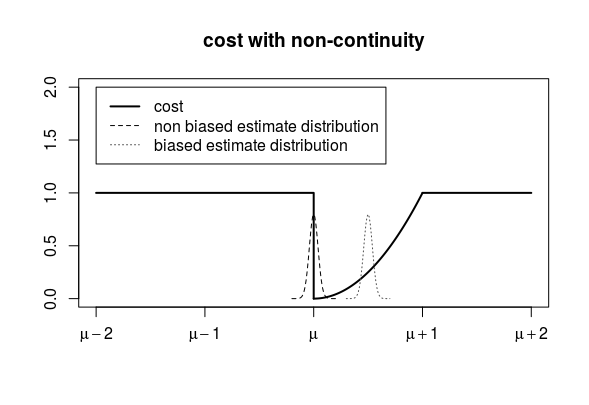In the previous question, the example by whuber was actually a cost function that was minimized when the estimate $t$ equals the true parameter value $t=\mu$, Namely it was zero for $\mu \leq t \leq \mu+1$, and thus at the minimum value for $t=\mu$.
Edit: The question has changed, but that example by whuber will still work, even when the minimum of the cost function is uniquely located at $t = \mu$. For instance consider this loss function:
$$L(t \vert \mu)= \begin{cases} 1 & \quad \text{if} \quad t < \mu \\
(t - \mu)^2& \quad\text{if}\quad \mu \leq t \leq \mu + 1 \\
1 & \quad\text{if}\quad \mu + 1 < t \end{cases}$$
The consistent estimator, which will approach $\mu$ for $n \to \infty$ will result in an expectation value for the cost of $0.5$, and any estimator with a slight bias overestimating the mean with $d$ will approach $d^2$ as the expectation value for the cost.
Continuity
The trick of that example is that the cost function had a discontinuity at the 'true parameter'.
If instead, the cost/loss function at the true parameter value $L(\mu)$ is continuous then the consistent estimator will approach this value (by the continuous mapping theorem)
$$ \lim_{n \to \infty} L(t_n) = L(\mu)$$
Then if $L(\mu)$ is also the lowest possible value $$\forall x\neq \mu : L(\mu) \leq L(x)$$ then the consistent estimator can not be outperformed for all $n$.
This is a bit of a handwaving argument, I imagine that there might be some pathological case where the cost function for the consistent estimator and the non-consistent estimator both approach the minimum value but the consistent estimator does this faster. E.g. adjust the cost function for whuber's example to be two blocks with some small size $d$, e.g. 0 for $\mu-d<t<\mu+d$ and 0 for $\mu+0.5-2d<t<\mu+0.5+2d$ and 1 elsewhere.
Unique minimum
In the case that $$\forall x\neq \mu : L(\mu) < L(x)$$ I can not imagine these pathological cases to remain.
(But maybe you should accurately define 'consistency' and 'dominate'/'outperform' because I can imagine discrepancies there, for instance consistent estimators with infinite variance, which will not dominate the variance of the error when compared with a biased estimator with finite variance)
Example plots:
In the plot below you can see that non-biased estimator is half the time negative (and for negative values the cost function is equal to one) which is why the expected value is >0.5 for any finite sample size.

In the next plot you can see that the cost function is at a minimum for the estimator equal to the true value, But, if this is not a unique minimum for the cost function (in the example the cost is 0 for all values $\mu \leq t \leq \mu+1$) then the limit for the biased estimator can be also the minimum value. In addition, the biased estimator has for all finite values a lower expected value of the cost function (because it is in the middle of the place where the cost value is zero, whereas the unbiased estimator is at the edge where the cost function is higher).

As noted in the other question. It is not every consistent estimator that performs less good than a non-consistent estimator.
In the first example we can make a biased but consistent estimator by letting the bias reduce to zero as the sample size increases, and for this estimator the estimated cost can get as close to zero as we like as long as we can increase the sample size without limit.
A comment by Richard Hardy was made related to the second example
I also wish we had a better suited vocabulary to discuss these problems. Both of the estimators in your answer are "consistent", but for different targets
We could call a consistent estimator an estimator that gets as close to the target value as we like by increasing the sample size. (e.g. close measured by the variance of the difference with the target going to zero).
Then
- If the cost function has a minimum at some point different from the mean (or when the minimum is not uniquely at the mean) then it is a bit trivial that the consistent estimator for the cost function is not necessarily a consistent estimator for the parameter estimate. And we might be able to construct non-consistent estimators (with respect to the parameter estimate) that perform better with respect to the cost.
- If there is a discontinuity of the cost function at the true parameter value, then not every consistent estimator for the parameter needs to be a consistent estimator for the cost function.


